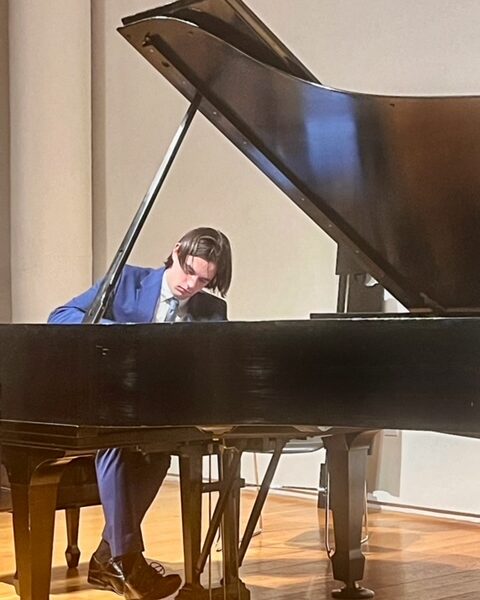Pianist Thomas Nickell in Review
Thomas Nickell, piano/composer
Tenri Cultural Center, New York, NY
February 16, 2024
An overflowing crowd was on hand at the Tenri Cultural Center on February 16, 2024, for a recital given by the talented young pianist/composer Thomas Nickell. The program consisted of three Philip Glass Etudes (Nos. 2, 6, and 8), Scottish Triptych by Ronald Stevenson, and two sonatas composed by Mr. Nickell. I’m going to forgo the usual linear path and group the works by each composer, regardless of the order in which they appeared in the program.
Let’s start with the Glass Etudes. Philip Glass wrote twenty etudes over a two-decade period, and divided them into two groups, Book 1 (1-10) and Book 2 (11-20). Glass writes (about Book 1) that his objective was to explore tempi, textures, and technique, with the goal of serving as a pedagogical tool by which he (Glass) would improve his piano playing. They are by no means “virtuosic” in the conventional sense, but they are much more challenging than they appear – with two of the most obvious examples being the need to play evenly without being robotic and the demand for balance of touch in the repetitions (a hallmark of Glass). Mr. Nickell dealt with these issues with a sure technique, never letting the energy flag while maintaining a musical sense throughout. It’s not an easy task, and it’s also something of a high-risk, low-reward proposition that many pianists would not take on in performance. If I had any qualms, it was that Mr. Nickell was overemphasizing the “loud” sections of Etude 6 (as it is never marked louder than forte) – that made it feel a bit more hectic than was necessary.
The Scottish composer Ronald Stevenson (1928-2015) is hardly unknown, but not a household name either. I suspect this was the first time many in the audience encountered his work (this listener was already acquainted with his two piano concerti). The three-movement Scottish Triptych (1959-1967) celebrates three eminent Scottish artists, song composer Francis George Scott, poet and polemicist Hugh MacDiamind, and poet Sorley MacLean. The writing is eclectic, reflecting the diverse talents of the artists profiled. For example, there is a name-initial motif (F, G, Eb(S), for Francis George Scott, a la DSCH), the influence of traditional Celtic music, and some “modern” percussive patterns and clusters. It is a challenging work for player and listener alike. It often dances on the edges of tonality without ever falling completely off, and there are quicksilver changes in mood and style (e.g., a stately funeral march suddenly gives way to a rapid-fire figuration ending in an angry outburst). In addition, there is use of extended techniques (playing inside the piano, strumming, and pizzicato). While Mr. Nickell has the requisite technique to deal with the difficulties that abound, it was the slower sections (especially the second movement), with his sensitive and poetic playing, that showed his artistry to its fullest extent. This work was the highlight of the evening for this listener.
Now, on to Mr. Nickell’s two compositions, Piano Sonatas Nos. 1 and 2. The Piano Sonata No.1 was “completed” in 2024, or rather the individual movements composed earlier were joined together in 2024. Mr. Nickell writes in his notes that each movement can be played as a stand-alone work (with a different title as well). This modular approach is interesting, but I’m still not convinced that these movements “go together” as a cohesive work. Each movement on its own is appealing and evocative, showing Mr. Nickell’s talent for composition, even if there were strong hints of Cowell, Crumb, Messiaen, and even Liszt’s B minor Sonata mixed in. The audience did not share my reservations, giving Mr. Nickell a hearty ovation.
The Sonata No. 2, Impressions after Gray’s Lanark, takes as its inspiration Scottish author Alasdair Gray’s 1981 novel Lanark. This novel, with strong Kafkaesque and Orwellian undertones, has become something of a cult classic. My first thought was that this was a modern attempt to copy Liszt’s Après une lecture du Dante: Fantasia quasi Sonata, but I quickly discarded that incorrect and unfair idea. In contrast to the First, this Sonata holds together very well! The three movements, Book 3, Oracle, and Epilogue: Prelude-Chorale-Fugue, all convey ideas and episodes from Lanark with remarkable skill. I could easily imagine hearing this music while reading the book. Bravo!
Mr. Nickell has undoubted talent, and as his talent continues to flourish, I expect his compositions to take on more of a distinctive voice that is less indebted to the influences of his role models. I look forward to hearing what the future holds for him.

